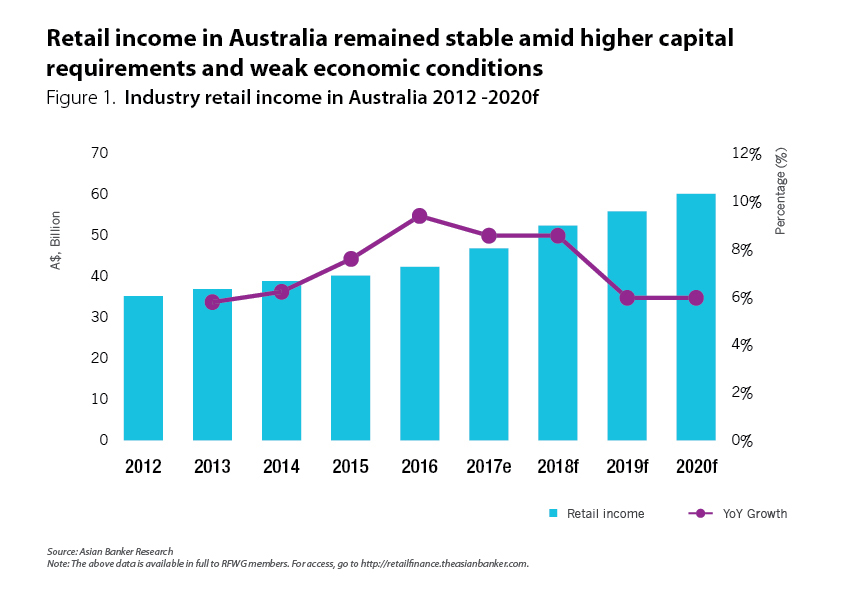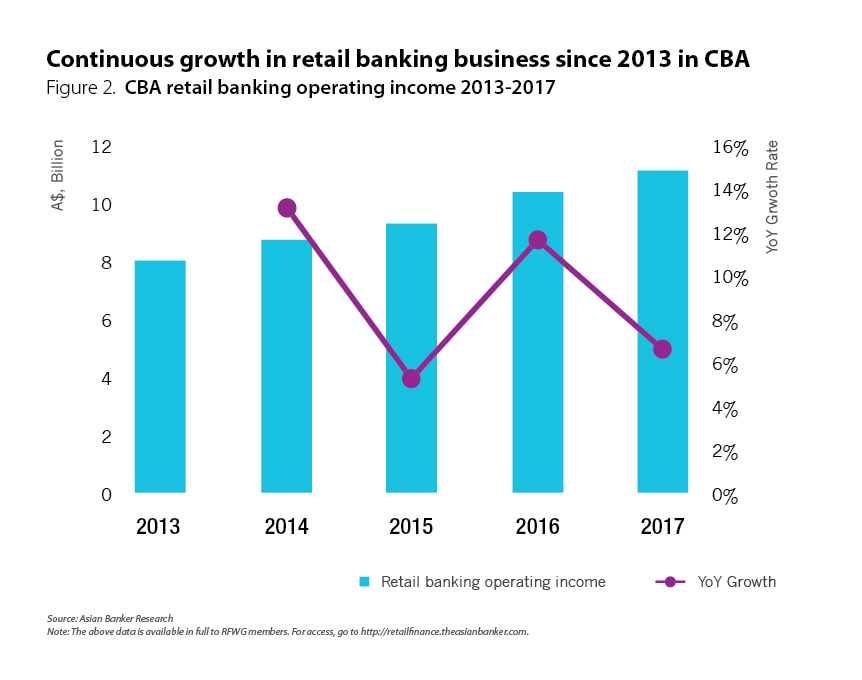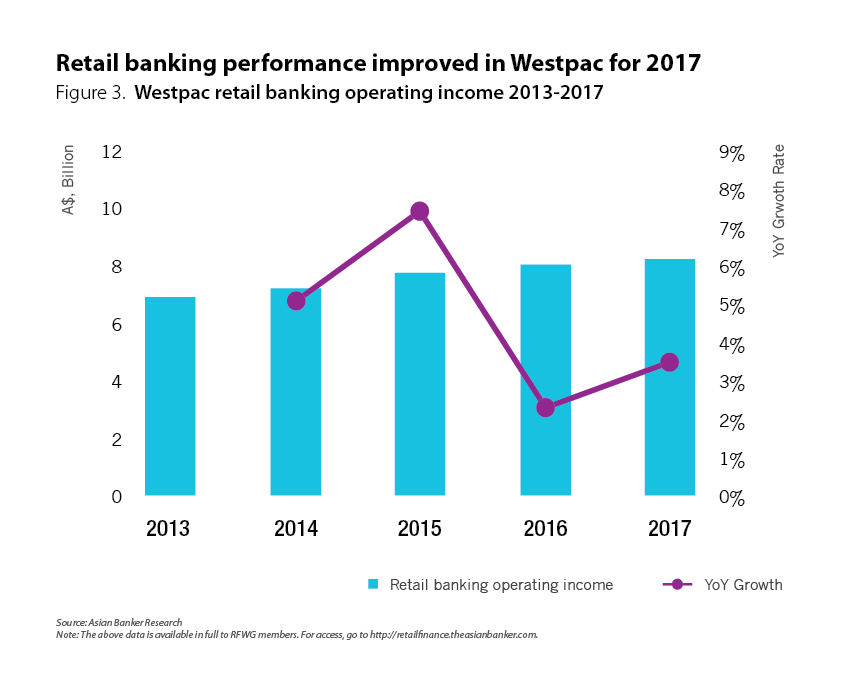- Australian retail banks are online data and analytics tools to gain better insights about their customers
- Local banks are looking at new technologies to drive growth and help customers better manage their finances
- Retail banks are harnessing the popularity of mobile phones to provide better products and more efficient services for consumers
Riding the wave of digitalisation, Australian banks have taken significant progress in the retail banking industry. Asian Banker Research estimates the overall retail banking income in Australia will reach $47.1 billion (A$61.5 billion) in 2020 (Figure 1). While electronic banking can be traced back to the advent of Electronic Funds Transfer at Point of Sale (EFTPOS), local retail banking services now face the need for digital transformation with customers using digital channels for bank transactions.

Riding this new trend in mobile banking, Australian banks have introduced mobile payments, cardless cash, and peer-to-peer (P2P) payments to attract customers. Advances in technology have revolutionised the way banks interact with their customers. Furthermore, banks are using online data and analytics tools to gain better insights about their customers, while increased investment in relevant technologies to enhance customers' banking experience.
Commonwealth Bank of Australia
In the last financial year, the Commonwealth Bank of Australia (CBA) has attained impressive achievements in the retail banking sector. As of June 2017, it has ranked number one in customer satisfaction amongst its peers, with retail customer satisfaction reaching 82.7%. Next year, the bank has decided to set more ambitious targets. The net promoter score (NPS) will become the primary metric used to assess customer satisfaction, with the goal of the bank to become number one in NPS in all customer segments. CBA aims to deliver greater customer experience across channels. A strategic priority this year was to enhance the home loan experience for customers by better integrating the branch, online and mobile channels.
To entice more customers to take a mortgage through CBA’s proprietary channels, the bank focused more on data gathering to better target consumer needs and preferences in an effort to better serve them. It also did well in new technology usage. Their findings showed one in three Australian households struggling to access $500 in an emergency, with more than a third of Australians spending more than they earned each month. Customer satisfaction goes hand in hand with the quality of digital products and services.
According to statistical data last year, 6.2 million of their customers used digital channels, such as NetBank, Online Bank service and CommBank, to bank with them, and more than half of all transactions by value occurred digitally. In order to help customers better manage their finances, CBA designed cutting-edge solutions in their digital system. In addition to the basic functions of the CommBank app, new functions, such as Camera Pay, Photo-a-bill, Instant Receipts, and Spend Tracker were all made available. Youth app, an app for children under 14 years, is aimed at teaching children how to manage their money responsibly under the guidance of their parents.
Furthermore, the CommBank Property App has changed the way local residents look for and buy property. The App was tested with over 100 home buyers in the usability testing space within the bank’s Sydney Innovation Lab. Home loan balances increased from $23 billion (A$30 billion) to $372 billion (A$486 billion), reflecting a 7% increase from the prior year.
In the latest financial year, retail banking services operated at $3.8 million (A$4.9 million) cash net profit after tax, increasing by 9% compared to the last financial year, and was above the increase in cash net profit after tax for the bank, which was 4.6% (Figure 2). Profits from retail banking services made up 50.5% of overall banking profits. Although the expenses and loan impairment has increased, the strong growth in total banking income drove the resulting high increase.

Westpac leverages digital innovation to drive client efficiency
Westpac is one of the leading retail banks in Australia with over $264 billion (A$345 billion) in retail banking assets. The bank is in close competition with the CBA and has started its service and technology revolution later but has seen some improvements across a variety of financial and service indicators. The bank brought Westpac, St.George, Bank of Melbourne, BankSA and RAMs under its consumer banking division with more than 8.9 million customers in Australia since June 2015. In 2016, consumer banking represented 38% of the Westpac Groups cash earnings, marking a 13% growth in financial performance in terms of revenue and cash earnings.
Westpac reported retail banking revenues and operating profits of A$8.0 billion and A$4.3 billion respectively for 2016, which achieved a 9% uplift in revenue and 14% rise in operating profits (Figure 3). The bank has also led the market in managing net interest margin, which increased by 2.35%. Lending also increased by 7.5%, driven by higher mortgage growth.

The bank also launched its “service promise” programme, which included a common set of service standards and behaviours, to deliver excellent customer service. As a result of its improved customer service design, more than 500,000 new customers joined Westpac. Westpac introduced more than 180 new features and enhancements across its digital channels in 2016 and made transactions simple and hassle-free. For example, customers are now able to activate their cards or manage a term deposit rollover via their smartphones, eliminating the need to visit a physical branch.
Furthermore, digital logins increased by 11%, and 23% of the bank’s sales are conducted through digital channels. Ninety-five percent of consumers’ banking transactions, including payments, are made through self-service channels.
Efficiencies gained through digital innovations, initiatives to simplify branch distribution and its product range have helped the bank reduce its cost to income to 40.8%, compared to 42.4% in 2015. Westpac has improved and simplified their customers’ smart phone experience. Customers can now connect to a customer service specialist 24/7 simply by tapping the “Connect” button on their mobile banking app. Without having to dial a phone number, customers can interact with a machine or answer security questions to identify themselves. Before connecting, they also have the option of choosing their enquiry type from an intuitive visual call menu, making sure their enquiry is resolved by the right specialist without them having to explain themselves. This function will be rolled out by Westpac this year. The bank keeps its lead in mobile and online capability for customers by fostering fintech initiatives.
Westpac created Reinventure, an independently run venture capital fund that directly invests in fintech businesses with the potential to make a significant impact in Australia. The bank also invested in Uno, a digital mortgage broker that provides its customers with the ability to search, compare and apply for a home loan digitally. These investments and innovations allow Westpac to gain insights into emerging fintech business models, adjacent business opportunities and entrepreneurial ways to execute at speed, thus realising more changes in the channels of consumer banking.
The outlook for Australian banks
Banks in Australia are facing new challenges and opportunities. Interest rates have grown over the last 25 years and the subdued growth requires a long duration in such a slow-growth environment. Every piece of information and strategy continues to draw a picture of the market. Banks will have to maintain strong capital levels, and at the same time comply with ever increasing international regulatory requirements, so they need to attract and service their large capital bases, which will only happen if they maintain strong levels of profits. Advancements in technology, especially for the banking sector, continues to move at an exponential rate.
Furthermore, there has been a recent focus on financial technology. As such, for banking sectors across the world, as well as for Australian retail banks, this trend of digitisation will not only change in scale and intensity, but also in speed. However, there is a race to capitalise on this trend of digitisation. The victor of this race would be the retail bank that is the quickest to implement changes, and the most effective in incorporating the developments of digitisation.
It may also be seen that the retail bank that provides the next gamechanger stands to gain a larger market share. Given the scale and swiftness of this trend, as well as the shifts in consumer demands and the way the consumer now sees banking, it is clear that digitisation might change the very nature of banking as we know it. Australian retail banks will and have to face these new challenges. Traditional ways need to be changed to some extent as customers demand a more approachable and convenient way to access banking services.
Some banks in Australia have decreased the number and size of their branches to save on capital and resources, to invest more in their digital system. Increasing competition means that banks cannot rest on their laurels. For now, retail banking in Australia is attempting to harness the popularity of mobile phones to provide better products and more efficient services for consumers. The utilisation of channels and simplified banking processes, as a result of technology, will be the prevailing trend in Australian retail banking.

































